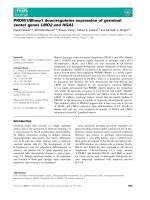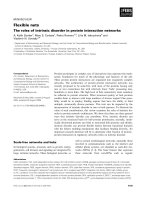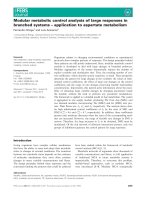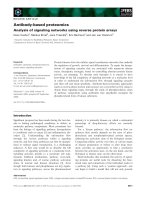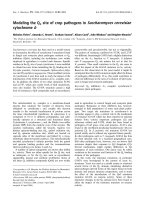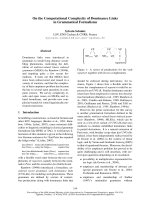Báo cáo khoa học: "Transcranial Doppler ultrasound analysis of resistive index in rostral and caudal cerebral arteries in dogs" pps
Bạn đang xem bản rút gọn của tài liệu. Xem và tải ngay bản đầy đủ của tài liệu tại đây (708.38 KB, 6 trang )
-2851$/ 2)
9H W H U L Q D U \
6FLHQFH
J. Vet. Sci.
(2005),
/
6
(1), 61–66
Transcranial Doppler ultrasound analysis of resistive index in rostral and
caudal cerebral arteries in dogs
Minho Seo, Hojung Choi, Kichang Lee, Mincheol Choi, Junghee Yoon*
College of Veterinary Medicine, Seoul National University, Seoul 151-742, Korea
Transcranial Doppler (TCD) was carried out to
determine the resistive index (RI) values of normal canine
cerebral arteries and its reproducibility and to evaluate
the change of cerebral vascular resistance following
diuretics administration. RI values of rostral cerebral
artery (RCA) were compared between fontanelle window
and temporal window. Normal ranges and reproducibility
of the RI values were examined in the rostal cerebral
artery (RCA) and caudal cerebral artery (CCA). And
after administration of diuretics, TCD-derived RI values
were measured at RCA and CCA. Cerebral vascular RI
values of RCA and CCA were 0.55 ± 0.05 and 0.55 ± 0.03
in the normal dogs, respectively. There was no significant
difference of RI between male and female; between
fontanelle window and temporal window. Reproducibility
of RI measurements between intraobserver and interobserver
were relatively high. The RI of RCA and CCA were
significantly increased 15 minutes after mannitol
administration (
p
< 0.01) and returned to baseline values
by 30 minutes, but it did not significantly change after
furosemide and saline administration. The results suggest
that TCD is a useful test which can obtain reproducible
results from any window and has the advantage of
detecting subtle changes in cerebral vascular resistance.
Key words:
Transcranial Doppler ultrasound, diuretics, dogs
Introduction
The use of Doppler ultrasound to estimate blood flow
velocity was described in 1960, but it was only in the 1980s
that it was appreciated that sufficient ultrasound would pass
through the skull to allow the detection of blood flow within
the intracranial circulation [1]. To achieve sufficient bone
penetration, low frequency (2 MHz) ultrasound is used. This
increases tissue penetration at the cost of poor spatial
resolution. Therefore, even with more recent transcranial
duplex scanners, two dimensional B mode images are of low
spatial resolution, and in adults the technique primarily
provides useful information about blood flow velocity.
Using various bone windows, where the barrier to the
ultrasound is thinnest, it is possible to insonate the proximal
middle, anterior, posterior cerebral arteries, the distal
internal carotid artery, and the intracranial vertebrobasilar
system. Location is achieved by the use of pulsed Doppler
ultrasound allowing determination of the depth of the
insonated vessel [1,5].
Transcranial Doppler (TCD) has a number of advantages
as a method of evaluating cerebral hemodynamics. It is
relatively cheap and non-invasive, allowing repeated
measurements and continuous monitoring. It has a high
temporal resolution making it ideal to study rapid changes in
cerebral hemodynamics [1,5]. The parameters evaluated at
TCD include direction of flow, velocity, and vascular
resistance. Dynamic changes in the pulsatility index (PI) and
the resistance index (RI), as calculated from TCD data,
allow for an assessment of the forces acting on the terminal
vasculature of the brain [12,24,32]. TCD is commonly
accepted as a method for evaluation of intracranial arterial
stenosis or occlusions and of arterial vasospasm after
subarachnoid hemorrhage [2,30]. Preliminary reports
suggested that TCD readings also might correlate with
intracranial pressure (ICP) elevation in patients with severe
brain edema and brain death after head injury, and in
hydrocephalic infants [12,15]. Previous studies demonstrated
a significant correlation between ICP and RI and reported
that changes in the RI appear to be useful indicators of
elevated ICP [12,24]. In addition, there was no significant
difference between RI measurements from fontanelle
window and temporal window. Therefore, RI measurements
using TCD can be obtained from any window [4].
In human, numerous cerebral vessels have been mapped
and their TCD parameters have been characterized using
TCD [1,5,6,13,18]. However, a few veterinary reports have
evaluated TCD of the canine brain in a limited population of
patients [28]. Location of RCA and CCA were reported in
B-mode ultrasound of dog and were adjacent to lateral
*Corresponding author
Tel: 82-2-880-1265; Fax: 82-2-880-8662
E-mail:
62 Minho Seo
et al.
ventricle and third ventricle [16]. Furthermore, these studies
were not conducted in conscious dogs. Specific normal
cerebral blood velocity parameters, as determined by TCD,
have not been reported in the veterinary literature for the
conscious dog, but are necessary for this diagnostic
methodology to achieve its full potential.
The use of diuretic agents for the reduction of elevated
ICP has been found to be effective and is widely recognized
as a suitable means of management of this condition
[3,14,21,23,31]. Mannitol, an osmotic diuretic, has been
commonly used clinically and experimentally for this
purpose, either on its own or in combination with other
diuretic agents. Furosemide, a distal loop diuretic, has been
used to lower ICP when used alone, although there is
conflicting experimental evidence for this in the normal and
edematous brain [22]. The effect of diuretics has been
evaluated by cerebral blood velocity parameter using TCD,
but has not been evaluated by RI of the cerebral vessel. This
study was performed to assess the feasibility of RI
measurement in the cerebral vasculature of normal
conscious dogs from fontanelle and temporal windows
using TCD, and the change of cerebral vascualr resistance
following administration of diuretic agents.
Materials and Methods
Experimental animals
Thirty seven clinically healthy dogs (aged from 3 months
to 10 years old; weighed from 0.82 to 4.20 kg) were used for
normal RI values of rostral cerebral artery (RCA) and
sixteen dogs (aged from 5 months to 7 years old; weighed
from 1.40 to 4.30 kg) were used for normal RI values of
caudal cerebral artery (CCA). All dogs fulfilled the
following inclusion criteria: no arrhythmia or ischemic heart
disease with electrocardiographic examination, heart rate in
the range of 70-160/s, no pulmonary disease, no hepatic
disease, hematocrit values within the range of 35-57%, and
normal blood pressure determined indirectly [19]. Ten dogs
were used for reproducibility and drug induced cerebral
vascular resistance changes. The dogs were housed indoor
for minimum 1 month and were fed a standardized diet
(Nestle Purina, Korea). All dogs were screened and
considered normal based on complete neurologic and
physical examinations prior to use in the study. The
experimental protocol was approved by the Animal Care
and Use Committee at Seoul National University.
Duplex Doppler imaging technique
Doppler sonography was performed with Toshiba SSA-
260A scanner (Toshiba, Japan), using a electronic sector
probe of 3.75 MHz. Standard Doppler power level was used
with a range gate length of 1.5 mm, pulse repetition
frequency of 4500 Hz, medium gain setting, and wall
filtering of 100 Hz. All dogs were given minimum 30
minutes for adapting to experimental environment. And
dogs remained in a sitting position throughout the trial
period. Coupling gel was applied above the zygomatic arch
and transverse scan was performed. The exact positioning of
the ultrasound probe was rather critical in most subjects. A
satisfactory signal could only be obtained in a restricted
region above the zygomatic arch, from 1 to 5cm in front of
the ear. An ultrasonic window had to be located in each
individual by searching this region to obtain the maximum
amplitude of the Doppler signals. In order to obtain the
Doppler signal in the RCA and CCA in transverse scans, the
sample volume was located at the sulci of the corpus
callosum, hyperechoic midline structure dorsal to lateral
ventricle and around the third ventricle, hyperechoic
structure continued to be seen in the midline (Fig. 1). After
consecutive equivalent-appearing Doppler waveforms were
obtained, the RI was calculated. The RI was obtained by
dividing the difference between the peak systolic (PSV) and
the end diastolic velocities (EDV) by the peak systolic
velocity:
RI = (PSV
−
EDV)/PSV
The RI was calculated for each vessel as an average value
obtained from three similar-appearing Doppler waveforms
to reduce the effects of physiologic variation.
Transcranial Doppler window
The RI of RCA was obtained from fontanelle window and
temporal window in 17 dogs.
Reproducibility
Intraobserver variation was calculated based on RI
measurements performed 3 times every other 7 day in 10
dogs. Interobserver variation was calculated based on RI
measurements performed from two observers in 10 dogs.
F
ig. 1. Angiography of cerebral vasculature (A) and Doppl
er
i
mages of the rostral cerebral artery (C), left caudal cerebr
al
a
rtery (B), and right caudal cerebral artery (D).
Transcranial Doppler analysis of cerebral arteries in dogs 63
Two observers participated in this study had over five year
experience and dedication to diagnostic imaging, particularly
ultrasonography. RI was obtained from RCA and CCA.
Variation was determined by intraclass correlation coeffecient.
Drug induced cerebral vascular resistance change
Ten dogs were used for evaluation of cerebral vascular
resistance change induced following administration of
diuretics using ultrasound. Mannitol, an osmotic diuretic,
and furosemide, a distal loop diuretic, were used to induced
cerebral vascular resistance change. Twenty percent
mannitol (Cheiljedang, Korea) was given in 1 g/kg dose IV
at 2 ml/kg/min, and furosemide (Lasix
®
, Handok Pharm.,
Korea) in 1 mg/kg IV. In addition, 0.9% saline is given in
same dose and rate as mannitol for controlling increased
volume. The RIs of RCA and CCA were obtained prior to
the infusion, after completion of the infusion and at 15, 30,
45, and 60 min. Withdrawal periods between each medication
were over 7 days.
Statistical analysis
Data were reported as means ± standard deviation (SD).
The RI measurement values of CCA are the average of right
and left CCA. Statistical analysis was performed using the
SPSS statistical computer program. The RIs in the RCA and
CCA obtained from male and female were compared using
independent t-test. The RI in RCA obtained from fontanelle
window and temporal window were compared using
independent t-test. In order to minimize interindividual
variability of physiological response, we compared baseline
values with subsequent measurements after the administration
of diuretics. Changes in RI were compared with baseline
value with ANOVA and the Scheffe post-hoc test.
Results
Duplex Doppler imaging of the cerebral vasculature
The mean RI value, standard deviation, and value range
for RCA and CCA were listed in Table 1. There was no
significant difference of RI between male and female. The
RIs of RCA from fontanelle window and temporal window
were 0.55 ± 0.04 and 0.56 ± 0.04, respectively. There was
no significant difference of RI between the windows. With
regard to intraobserver and interobserver variation, the
intraclass correlation coefficient between measurements for
the RI values was summarized in Table 2. There was no
significant difference between RI values of RCA and CCA,
these values were reproducible. The RI values of CCA were
relatively more reproducible than those of RCA in
interobserver variation.
Drug induced cerebral vascular resistance change
Every single measurement was performed within 3
minutes. The RI of RCA (
p
< 0.01) and CCA (
p
< 0.01)
were significantly increased 15 min after the administration
of mannitol and returned to baseline value, 0.56 by 30 min,
whereas not significantly changed after furosemide and
saline administration (Fig. 2).
Discussion
In human, normal limits of TCD-induced RI measurements
in the cerebral vessels were reported. The RIs have positive
correlation with ICP, therefore RI was useful as noninvasive
indicators of an elevated ICP [24,28]. However, normal
limits of RI measurements in cerebral vessels of the normal
conscious dogs were not reported. A variety of neurological
disorders was associated with intracranial hypertension.
Invasive ICP measurements in intracranial cerebrospinal
fluid (CSF) spaces or in brain parenchyma were accepted as
the gold standard in neurosurgery and these methods called
for general or at least local anesthesia and carried the
common risks of surgical procedures, such as intracerebral
bleeding or infection [9]. Therefore, some attempts have
Table 1.
Normal mean RI values of RCA and CCA in dogs
Variable n Mean±SD Range
RCA 37 0.55±0.05 0.46~0.64
Male
13
0.54±0.06
0.46~0.64
Female
24
0.55±0.05
0.47~0.64
CCA
16 0.55±0.03 0.50~0.60
Male
8
0.55±0.03
0.50~0.58
Female 8 0.56±0.02 0.53~0.60
SD: standard deviation, RCA: rostral cerebral artery, CCA: caudal
cerebral artery
Table 2.
Reproducibility of the RI values of RCA and CCA in
dogs
Parameter Mean SD
Reliability
coefficient (
κ
)
Intraobserver
RCA
first 0.57 0.02
second 0.55 0.02 0.81
third 0.56 0.02
CCA
first 0.56 0.02
second 0.56 0.02 0.62
third 0.55 0.02
Interobserver
RCA
one 0.56 0.03
0.62
other 0.55 0.02
CCA
one 0.56 0.02
0.92
other 0.56 0.02
RCA: rostral cerebral artery, CCA: caudal cerebral artery
64 Minho Seo
et al.
been made to establish reliable noninvasive techniques for
ICP measurement which may be considered an alternative to
invasive methods [25].
TCD has the advantage of being noninvasive, easily
handled, and working in real time. Monitoring of cerebral
blood flow velocity (CBFV) with the TCD technique,
however, has several limitations and possible sources of
errors. Variability of TCD velocities depends strongly on the
skill of the investigator and the angle of insonation [5], since
it is sometimes difficult to determine the angle of the probe
to the intracerebral vessel with a high degree of accuracy,
absolute velocity measurements are difficult to compare.
Brain imaging can be assessed using a craniotomy or open
fontanelle as an acoustic window in adult dogs [16] and
neonates [17]. The B-mode ultrasonographic characteristics
of both the normal and hydrocephalic canine brain have
been described [16,33]. Although numerous cerebral vessels
have been mapped and their TCD parameters characterized
using TCD in human, few veterinary reports have evaluated
TCD of the canine brain, even in a limited population of
patients. In transverse scan at the level of the interthalamic
adhesion, pulsations seen on real-time images were
remarkable in the sulci of the corpus callosum and around
the third ventricle [16]. The RCA extends rostrocaudally
along the dorsal surface of the corpus callosum. The CCA
extends dorsomedially along the lateral surface of the brain
stem and supplies the choroid plexus of the third ventricle.
The RCA and the CCA are responsible for the pulsations. RI
measurements can be obtained at the distal branch of these
vessels. They may reflect the resistance of distal cerebral
arteries. The normal canine cerebral vessels identified in this
study are the RCA and CCA. The RCA is difficult to be
identified using transtemporal window, but easy in
transverse and sagittal scans of dogs with open fontanelle
using transfontanelle window. But the CCA is easily
identified in transverse scans using transtemporal window.
This may be related to extension of the cerebral arteries. In
addition, color Doppler imaging (CDI) may help identify
these vessels. For these reasons, preferred cerebral artery is
the RCA in transfontanelle window and the CCA in
transtemporal window. There was no significant difference
between RI measurements from transfontanelle window and
transtemporal window [4]. Therefore, RI measurements
using TCD can be obtained from any window and an
ultrasonic window had to be located in each individual by
searching preferred window to obtain the maximum
amplitude of the Doppler signals. This is similar to the result
of this study. In this study, the mean RI values of the RCA
and CCA were 0.55 ± 0.05 and 0.55 ± 0.03. The mean RI
values of dogs are similar to the mean RI values (0.5-0.6) of
human [29]. In human, the mean RI value of the intracranial
arteries in term infants during the first 24h of life was
0.75 ± 0.10 [28]. The data corresponded to the known
downward trend of the RI during the first year of life [29].
After fontanelle closure, the mean RI was decreased to the
range between 0.50 and 0.60. RI values were in the range of
0.8-0.75 for prematures, 0.7-0.65 for term babies, and
gradually decreased during the first few months of life to
reach adult values. In dogs, there is no study reported about
normal RI values of intracranial arteries. In the present
study, dogs below 3 months are excluded because they
would be expected to have a higher RI. We thought that the
mean RI values of this study were the RI values of
intracranial arteries in normal adult dogs [11]. It was thought
that RI values of normal dogs under 3 months are studied.
High reproducibility is critical for the TCD system,
especially if this methodology is used to detect small
difference in the blood velocity parameters that may occur in
intracranial disease, and in the evaluation and comparisons
of various medical and/or surgical treatment. In this study,
high reproducibility was demonstrated in selected cerebral
arteries in normal conscious dogs. Therefore, these
measurements were highly reproducible, and might permit
F
ig. 2.
The RI of rostral cerebral artery (RCA) and caud
al
c
erebral artery (CCA) at baseline and at various times followi
ng
t
he start of mannitol (1 g/kg), furosemide (1 mg/kg), and sali
ne
(
5 ml/kg) infusion. Values are means ± standard deviation.
Transcranial Doppler analysis of cerebral arteries in dogs 65
valid comparisons to the blood flow parameters of certain
intracranial diseases that possess vascular resistance changes.
This study was sought to demontrate the cerebral blood
flow velocity correlates of a hemodynamic effect of
mannitol and furosemide using TCD. Dosage and rate of
mannitol and furosemide are based on the study reported by
Roberts
et al
[26]. They found that the higher mannitol dose
(1 g/kg), resulting in a greater blood-brain osmotic gradient,
proved to be the most efficacious in ICP reduction and rapid
administration (2 ml/kg/min) produced higher peak serum
concentrations of mannitol and more profound lowering of
ICP than the same dose delivered at slower rates.
We observed that RI of the RCA and the CCA increased
15 min after the administration of mannitol and returned to
baseline values by 30 min. This data were similar to the
result of study reported by Soriano
et al.
[32]. Mannitol has
been shown to increase the cerebral blood flow due to a
transient hypervolemia, decrease blood viscosity due to
hemodilution, and alter red blood cell deformity [8,10,27].
The end result of these effects is a reflex vasoconstriction of
the cerebral arterioles, which allows a decrease in cerebral
blood volume, and therefore, a decrease in the ICP [21].
Therefore, changes of RI values after mannitol except initial
effect would be related to change of cerebral blood flow and
vasoconstriction, which is normal autoregulation of cerebral
vessels.
The RI of the RCA and CCA after infusion of furosemide
did not significantly change in this study. Most investigators
have assumed that furosemide reduces ICP by decreasing
brain sodium levels and water transport as well as lowering
CSF volume by adversely affecting cation transport into the
ventricular cavity. Many clinical and experimental studies
appear to indicate that furosemide reduce ICP in the normal
and edematous brain [7,20]. However, the result of the
present study is not consistent with previous studies, but
may be related to vasoconstriction without sharp change of
ICP secondary to cerebral blood flow.
This study suggests that TCD may have several promising
applications in veterinary neurology. Quantitative assessment
of the RI of RCA and CCA prove to be useful and
sufficiently reproducible, which this non-invasive and
clinically easy-to-perform technique may give physiologic
and pathophysiologic information in a number of cerebral
diseases.
References
1. Aaslid R, Markwaler TM, Nornes H. Noninvasive
transcranial Doppler ultrasound recording of flow velocity in
basal cerebral arteries. J Neurosurg 1982, 57, 769-774.
2. Aaslid R, Haber P, Nornes H. Evaluation of cerebrovascular
spasm with transcranial Doppler ultrasound. J Neurosurg
1984, 60, 37-41.
3. Albright AL, Latchaw RE, Robinson AG. Intracranial and
systemic effects of osmotic and oncotic therapy in
experimental cerebral edema. J Neurosurg 1984, 60, 481-
489.
4. Allison JW, Faddis LA, Kinder DL, Roberson RK,
Glasier CM, Seibert JJ. Intracranial resistive index(RI)
values in normal term infants during the first day of life.
Pediatr Radiol, 2000, 30, 618-620.
5. Arnolds BJ, Reutern GMV. Transcranial Doppler
sonography. Examination technique and normal reference
values. Ultrasound Med Biol 1986, 12, 115-123.
6. Bishop CCR, Powell S, Rutt D, Browse NL. Transcranial
Doppler measurement of middle cerebral artery blood flow
velocity: A validation study. Stroke 1986, 17, 913-915.
7. Buhrley LE, Reed DJ. The effect of furosemide on sodium-
22 uptake into cerebrospinal fluid and brain. Exp Brain Res
1972, 14, 503-510.
8. Burke AM, Quest DO, Chein S, Cerri C. The effects of
mannitol on blood viscosity. J Neurosurg 1981, 55, 550-553.
9. Czech T, Korn A, Reinprecht A. Clinical evaluation of a
new epidural pressure monitor. Acta Neurochir, 1993, 125,
169-172.
10. Donato T, Shapira Y, Artru A, Powers K. Effect of
mannitol on cerebrospinal fluid dynamics and brain tissue
edema. Anesth Analg 1994, 78, 58-66.
11. Fontaine S, Lafortune M, Cattin F, Patriquin H. The role
of transcranial Doppler in diagnostic neuroimaging. J Radiol
1998, 79, 213-225.
12. Goh D, Minns RA, Hendry GMA, Thambyayah M,
Steers AJW. Cerebrovascular resistive index assessed by
Duplex Doppler sonography and its relationship to
intracranial pressure in infantile hydrocephalus. Pediatr
Radiol 1992, 22, 246-250.
13. Hart R, Haluszkiewicz E. Blood flow velocity using
transcranial doppler velocimetry in the middle and anterior
cerebral arteries: Correlation with sample volume depth.
Ultrasound Med Biol 2000, 26, 1267-1274.
14. Hartwell RC, Sutton LN. Mannitol, intracranial pressure,
and vasogenic edema. Neurosurgery 1993, 32, 444-450.
15. Homburg AM, Jakobsen M, Enevoldsen E. Transcranial
Doppler recordings in raised intracranial pressure. Acta
Neurol Scand 1993, 87, 488-493.
16. Hudson JA, Cartee RE, Simpson ST, Buxton DF.
Ultrasonographic anatomy of the canine brain. Radiology
1989, 30, 13-21.
17. Hudson JA, Simpson ST, Cox NR, Buxton DF.
Ultrasonographic examination of the normal canine neonatal
brain. Vet Radiol 1991, 32, 50-59.
18. Lunt MJ, Jenkinson DF, Kerr D. Transcranial Dopper
blood velocity mesurement-The effect of changes in velocity
profile. Ultrasound Med Biol 2000, 26, 1145-1151.
19. Meurs KM, Miller MW, Slater MR, Glaze K. Arterial
blood pressure measurement in a population of healthy
geriatric dogs. J Am Anim Hosp Assoc 2000, 36, 497-500.
20. Millison C, James HE, Shapiro HM. Intracranial
hypertension and brain oedema in albino rabbits. Part 2:
Effects of acute therapy with diuretics. Acta Neurochir 1981,
56, 167-181.
21. Muizerlaar JP, Lutz III HA, Becker DP. Effect of mannitol
on ICP and CBF and correlation with pressure auroregulation
66 Minho Seo
et al.
in severely head-injured patients. J Neurosurg 1984,
61
, 700-
706.
22.
Pollay M, Fullenwider C, Roberts A, Stevens A.
Effect of
mannitol and furosemide on blood-brain osmotic gradient
and intracranial pressure. J Neurosurg 1983,
59
, 945-950.
23.
Qureshi AI, Wilson DA, Traystman RJ.
Treatment of
elevated intracranial pressure in experimental intracerebral
hemorrhage: Comparision between mannitol and hypertonic
saline. Neurosurgery 1999,
44
, 1055-1064.
24.
Rainov NG, Weise JB, Burkert W.
Transcranial Doppler
sonography in adult hydrocephalic patients. Neurosurg Rev
2000,
23
, 34-38.
25.
Reid A, Marchbanks RJ, Bateman DE, Martin AM,
Brightwell AP, Pickard JD.
Mean intracranial pressure
monitoring by an audiological technique: a pilot study. J
Neurol Neurosurg Psychiatry 1989,
52
, 610-612.
26.
Roberts PA, Pollay M, Engles C, Pendleton B, Reynolds
E, Stevens FA.
Effect on intracranial pressure of furosemide
combined with varying doses and administration rates of
mannitol. J Neurosurg 1987,
66
, 440-446.
27.
Rudehill A, Lagerkranser M, Lindquist C, Gordon E.
Effects of mannitol on blood volume and central
hemodynamics in patients undergoing cerebral aneurysm
surgery. Anesth Analg 1983,
62
, 875-880.
28.
Seibert JJ, McCowan TC, Chadduck WM, Adametz JR,
Glasier CM, Williamson SL, Taylor BJ, Leithiser RE,
McConnell JR, Stansell CA, Rodgers AB, Corbitt SL.
Duplex pulsed Doppler US versus intracranial pressure in the
neonate: clinical and experimental studies. Radiology 1989,
171
, 155-159.
29.
Seibert JJ, Glasier CM, Leithiser RE.
Transcranial
Doppler using standard duplex equipment in children.
Ultrasound 1990,
8
, 167-196.
30.
Seiler RW, Grolimund P, Aaslid R, Huber P, Nornes H.
Cerebral vasospasm evaluated by transcranial ultrasound
correlated with clinical grade and CT-visualized subarachnoid
hemorrhage. J Neurosurg 1986,
64
, 594-600.
31.
Silver P, Nimkoff L, Siddiqi Z, Estrada R, Sagy M.
The
effect of mannitol on intracranial pressure in relation to
serum osmolality in a cat model of cerebral edema. Intensive
Care Med 1996,
22
, 434-438.
32.
Soriano SG, McManus ML, Sullivan LJ, Rockoff MA,
Black PM, Burrows FA.
Cerebral blood flow velocity after
mannitol infusion in children. Can J Anaesth 1996,
43
, 461-
466.
33.
Spaulding KA, Sharp NJH.
Ultrasonographic imaging of
the lateral cerebral ventricle in the dog. Vet Radiol 1990,
31
,
59-64.


